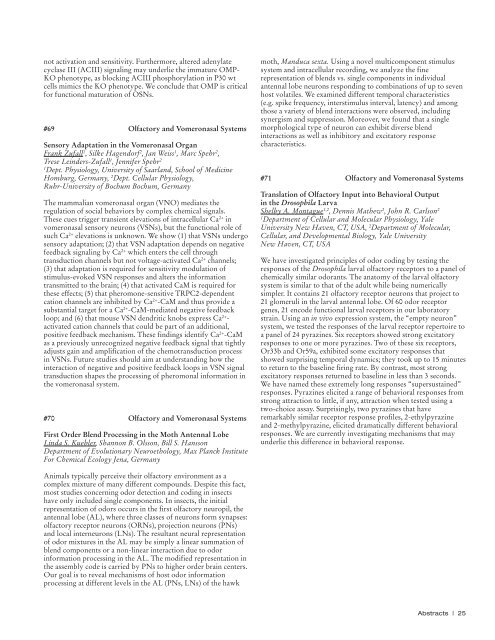2009 Abstracts - Association for Chemoreception Sciences
2009 Abstracts - Association for Chemoreception Sciences
2009 Abstracts - Association for Chemoreception Sciences
Create successful ePaper yourself
Turn your PDF publications into a flip-book with our unique Google optimized e-Paper software.
not activation and sensitivity. Furthermore, altered adenylatecyclase III (ACIII) signaling may underlie the immature OMP-KO phenotype, as blocking ACIII phosphorylation in P30 wtcells mimics the KO phenotype. We conclude that OMP is critical<strong>for</strong> functional maturation of OSNs.#69 Olfactory and Vomeronasal SystemsSensory Adaptation in the Vomeronasal OrganFrank Zufall 1 , Silke Hagendorf 2 , Jan Weiss 1 , Marc Spehr 2 ,Trese Leinders-Zufall 1 , Jennifer Spehr 21Dept. Physiology, University of Saarland, School of MedicineHomburg, Germany, 2 Dept. Cellular Physiology,Ruhr-University of Bochum Bochum, GermanyThe mammalian vomeronasal organ (VNO) mediates theregulation of social behaviors by complex chemical signals.These cues trigger transient elevations of intracellular Ca 2+ invomeronasal sensory neurons (VSNs), but the functional role ofsuch Ca 2+ elevations is unknown. We show (1) that VSNs undergosensory adaptation; (2) that VSN adaptation depends on negativefeedback signaling by Ca 2+ which enters the cell throughtransduction channels but not voltage-activated Ca 2+ channels;(3) that adaptation is required <strong>for</strong> sensitivity modulation ofstimulus-evoked VSN responses and alters the in<strong>for</strong>mationtransmitted to the brain; (4) that activated CaM is required <strong>for</strong>these effects; (5) that pheromone-sensitive TRPC2-dependentcation channels are inhibited by Ca 2+ -CaM and thus provide asubstantial target <strong>for</strong> a Ca 2+ -CaM-mediated negative feedbackloop; and (6) that mouse VSN dendritic knobs express Ca 2+ -activated cation channels that could be part of an additional,positive feedback mechanism. These findings identify Ca 2+ -CaMas a previously unrecognized negative feedback signal that tightlyadjusts gain and amplification of the chemotransduction processin VSNs. Future studies should aim at understanding how theinteraction of negative and positive feedback loops in VSN signaltransduction shapes the processing of pheromonal in<strong>for</strong>mation inthe vomeronasal system.#70 Olfactory and Vomeronasal SystemsFirst Order Blend Processing in the Moth Antennal LobeLinda S. Kuebler, Shannon B. Olsson, Bill S. HanssonDepartment of Evolutionary Neuroethology, Max Planck InstituteFor Chemical Ecology Jena, Germanymoth, Manduca sexta. Using a novel multicomponent stimulussystem and intracellular recording, we analyze the finerepresentation of blends vs. single components in individualantennal lobe neurons responding to combinations of up to sevenhost volatiles. We examined different temporal characteristics(e.g. spike frequency, interstimulus interval, latency) and amongthose a variety of blend interactions were observed, includingsynergism and suppression. Moreover, we found that a singlemorphological type of neuron can exhibit diverse blendinteractions as well as inhibitory and excitatory responsecharacteristics.#71 Olfactory and Vomeronasal SystemsTranslation of Olfactory Input into Behavioral Outputin the Drosophila LarvaShelby A. Montague 1,2 , Dennis Mathew 2 , John R. Carlson 21Department of Cellular and Molecular Physiology, YaleUniversity New Haven, CT, USA, 2 Department of Molecular,Cellular, and Developmental Biology, Yale UniversityNew Haven, CT, USAWe have investigated principles of odor coding by testing theresponses of the Drosophila larval olfactory receptors to a panel ofchemically similar odorants. The anatomy of the larval olfactorysystem is similar to that of the adult while being numericallysimpler. It contains 21 olfactory receptor neurons that project to21 glomeruli in the larval antennal lobe. Of 60 odor receptorgenes, 21 encode functional larval receptors in our laboratorystrain. Using an in vivo expression system, the “empty neuron”system, we tested the responses of the larval receptor repertoire toa panel of 24 pyrazines. Six receptors showed strong excitatoryresponses to one or more pyrazines. Two of these six receptors,Or33b and Or59a, exhibited some excitatory responses thatshowed surprising temporal dynamics; they took up to 15 minutesto return to the baseline firing rate. By contrast, most strongexcitatory responses returned to baseline in less than 3 seconds.We have named these extremely long responses “supersustained”responses. Pyrazines elicited a range of behavioral responses fromstrong attraction to little, if any, attraction when tested using atwo-choice assay. Surprisingly, two pyrazines that haveremarkably similar receptor response profiles, 2-ethylpyrazineand 2-methylpyrazine, elicited dramatically different behavioralresponses. We are currently investigating mechanisms that mayunderlie this difference in behavioral response.Animals typically perceive their olfactory environment as acomplex mixture of many different compounds. Despite this fact,most studies concerning odor detection and coding in insectshave only included single components. In insects, the initialrepresentation of odors occurs in the first olfactory neuropil, theantennal lobe (AL), where three classes of neurons <strong>for</strong>m synapses:olfactory receptor neurons (ORNs), projection neurons (PNs)and local interneurons (LNs). The resultant neural representationof odor mixtures in the AL may be simply a linear summation ofblend components or a non-linear interaction due to odorin<strong>for</strong>mation processing in the AL. The modified representation inthe assembly code is carried by PNs to higher order brain centers.Our goal is to reveal mechanisms of host odor in<strong>for</strong>mationprocessing at different levels in the AL (PNs, LNs) of the hawk<strong>Abstracts</strong> | 25
















